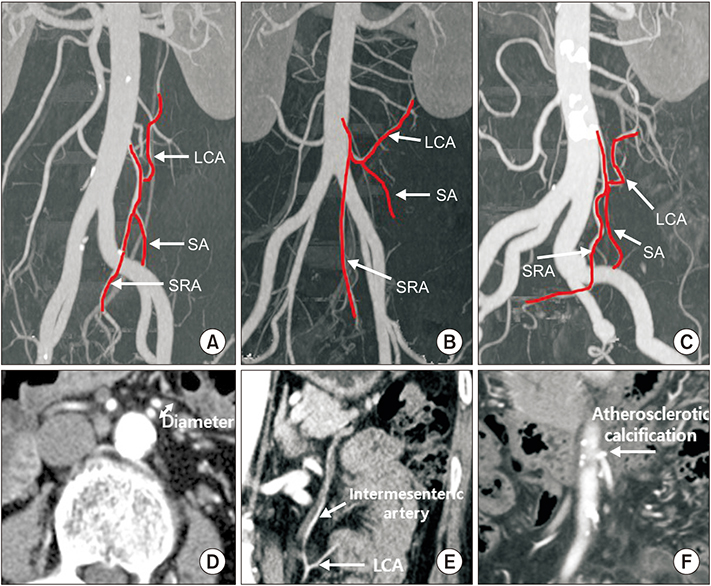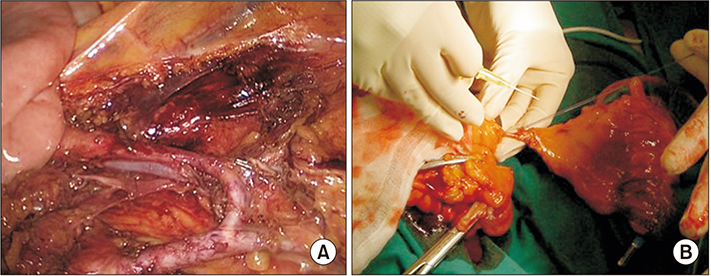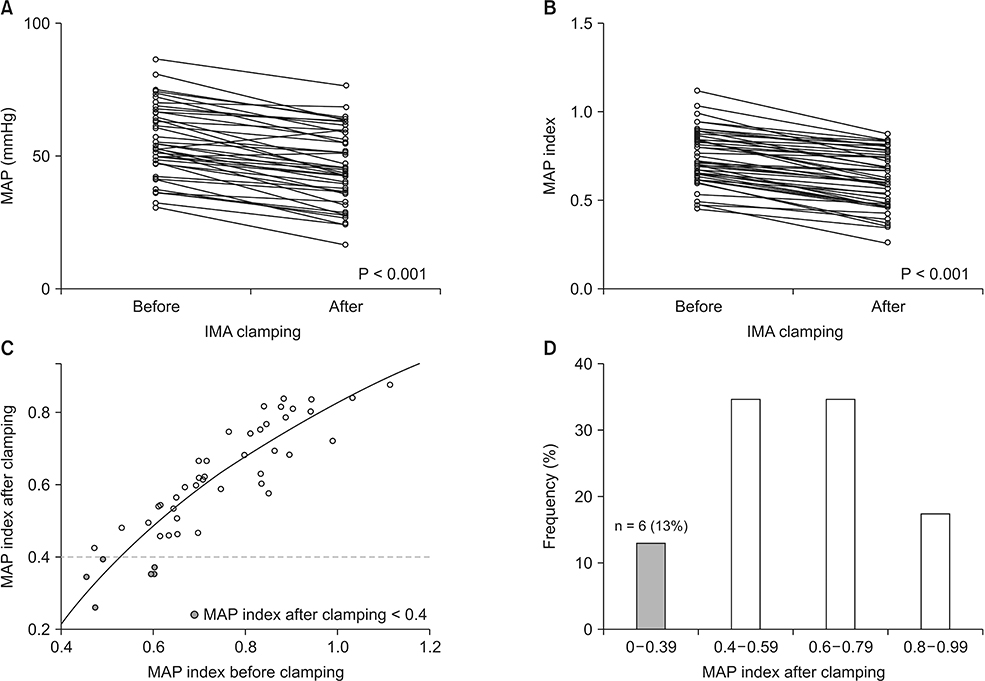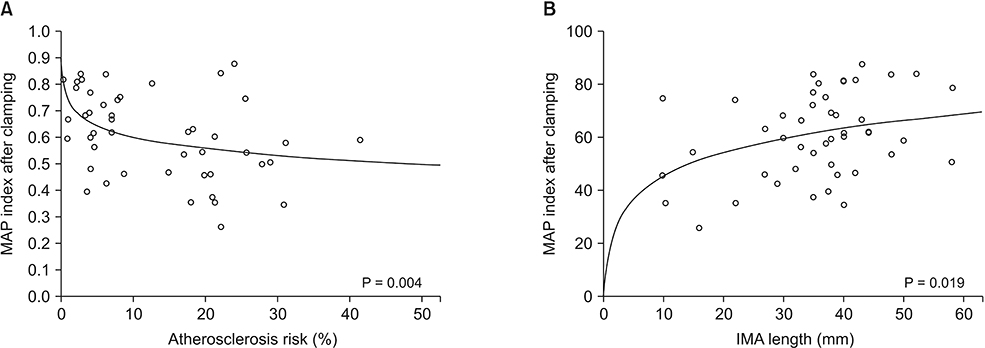Ann Surg Treat Res.
2019 Aug;97(2):74-82. 10.4174/astr.2019.97.2.74.
Colonic hypoperfusion following ligation of the inferior mesenteric artery in rectosigmoid colon cancer patients
- Affiliations
-
- 1Department of Surgery, School of Medicine, Pusan National University, Yangsan, Korea. skm1711@pusan.ac.kr
- 2Research Institute for Convergence of Biomedical Science and Technology, Pusan National University Yangsan Hospital, Yangsan, Korea.
- 3Department of Radiology, School of Medicine, Pusan National University, Yangsan, Korea.
- 4Department of Anesthesia and Pain Medicine, School of Medicine, Pusan National University, Yangsan, Korea.
- KMID: 2455981
- DOI: http://doi.org/10.4174/astr.2019.97.2.74
Abstract
- PURPOSE
Colon perfusion status is one of the most important factors for the determination of postoperative anastomotic complications. Colonic hypoperfusion can be induced by inferior mesenteric artery (IMA) ligation in some patients. This study aimed to evaluate atherosclerotic risk assessment and vascular parameters of CT angiography as predictors of colonic hypoperfusion.
METHODS
This prospective study was conducted at a tertiary referral hospital and included 46 rectosigmoid colon cancer patients undergoing laparoscopic anterior resection between August 2013 to July 2014. Atherosclerotic risk scores were assessed using the Framingham cardiovascular risk score system. The IMA length, branching pattern, atherosclerotic calcification, and intermesenteric artery and mesenteric vascular diameters were evaluated using CT angiography. Mesenteric marginal artery pressures were measured before and after IMA clamping. The mean arterial pressure (MAP) index was calculated by dividing the mesenteric marginal MAP into the systemic MAP to determine the mesenteric hypoperfusion status after IMA clamping. A critically low MAP index was defined as <0.4.
RESULTS
Critically low MAP index (<0.4) was observed in 6 cases (13.0%) after IMA clamping. Atherosclerotic calcification of the IMA and superior mesenteric artery occurred in 11 (23.9%) and 5 patients (10.9%), respectively. Low MAP index was associated with high atherosclerotic risk score and short IMA length, rather than atherosclerotic calcification and other vascular parameters of the major mesenteric arteries. Multivariate analysis indicated that high atherosclerotic risk and short IMA length were independent predictors of critically low MAP index.
CONCLUSION
Atherosclerotic risk assessment and IMA length were useful predictors of the mesenteric hypoperfusion status following IMA ligation during laparoscopic rectosigmoid colon surgery.
Keyword
MeSH Terms
Figure
Reference
-
1. Rao X, Zhang J, Liu T, Wu Y, Jiang Y, Wang P, et al. Prognostic value of inferior mesenteric artery lymph node metastasis in cancer of the descending colon, sigmoid colon and rectum. Colorectal Dis. 2018; 20:O135–O142.
Article2. Lee KH, Kim JS, Kim JY. Feasibility and oncologic safety of low ligation of inferior mesenteric artery with D3 dissection in cT3N0M0 sigmoid colon cancer. Ann Surg Treat Res. 2018; 94:209–215.
Article3. Park JS, Choi GS, Kim SH, Kim HR, Kim NK, Lee KY, et al. Multicenter analysis of risk factors for anastomotic leakage after laparoscopic rectal cancer excision: the Korean laparoscopic colorectal surgery study group. Ann Surg. 2013; 257:665–671.4. Son GM, Kwon MS, Kim Y, Kim J, Kim SH, Lee JW. Quantitative analysis of colon perfusion pattern using indocyanine green (ICG) angiography in laparoscopic colorectal surgery. Surg Endosc. 2019; 33:1640–1649.
Article5. Sindhu RS, Natesh B, Rajan R, Shanavas K, Sukumaran G, Gayathri LK. Low-tie IMA and selective D3 lymph node sampling in laparoscopic rectal resection for carcinoma rectum: comparison of surgical and oncological outcomes with the open technique. J Gastrointest Oncol. 2017; 8:850–857.
Article6. Kachlik D, Baca V. Macroscopic and microscopic intermesenteric communications. Biomed Pap Med Fac Univ Palacky Olomouc Czech Repub. 2006; 150:121–124.
Article7. Fujii S, Ishibe A, Ota M, Suwa H, Watanabe J, Kunisaki C, et al. Short-term and long-term results of a randomized study comparing high tie and low tie inferior mesenteric artery ligation in laparoscopic rectal anterior resection: subanalysis of the HTLT (High tie vs. low tie) study. Surg Endosc. 2019; 33:1100–1110.
Article8. Miyamoto R, Nagai K, Kemmochi A, Inagawa S, Yamamoto M. Three-dimensional reconstruction of the vascular arrangement including the inferior mesenteric artery and left colic artery in laparoscope-assisted colorectal surgery. Surg Endosc. 2016; 30:4400–4404.
Article9. Champagne BJ, Lee EC, Valerian B, Mulhotra N, Mehta M. Incidence of colonic ischemia after repair of ruptured abdominal aortic aneurysm with endograft. J Am Coll Surg. 2007; 204:597–602.
Article10. Brandt LJ, Feuerstadt P, Longstreth GF, Boley SJ. American College of Gastroenterology. ACG clinical guideline: epidemiology, risk factors, patterns of presentation, diagnosis, and management of colon ischemia (CI). Am J Gastroenterol. 2015; 110:18–44.
Article11. D'Agostino RB Sr, Vasan RS, Pencina MJ, Wolf PA, Cobain M, Massaro JM, et al. General cardiovascular risk profile for use in primary care: the Framingham Heart Study. Circulation. 2008; 117:743–753.12. Jahangiry L, Farhangi MA, Rezaei F. Framingham risk score for estimation of 10-years of cardiovascular diseases risk in patients with metabolic syndrome. J Health Popul Nutr. 2017; 36:36.
Article13. Ke J, Cai J, Wen X, Wu X, He Z, Zou Y, et al. Anatomic variations of inferior mesenteric artery and left colic artery evaluated by 3-dimensional CT angiography: insights into rectal cancer surgery - A retrospective observational study. Int J Surg. 2017; 41:106–111.
Article14. Hiltunen A, Kivisaari L, Leino-Arjas P, Vehmas T. Visual scoring of atherosclerosis in chest computed tomography: findings among male construction workers. Acta Radiol. 2008; 49:328–336.
Article15. Ernst CB, Hagihara PF, Daugherty ME, Griffen WO Jr. Inferior mesenteric artery stump pressure: a reliable index for safe IMA ligation during abdominal aortic aneurysmectomy. Ann Surg. 1978; 187:641–646.16. Hsu TC. Inferior mesenteric artery stump pressure is an unreliable predictor of the outcome of colorectal anastomosis. Int J Colorectal Dis. 2007; 22:1481–1484.
Article17. Guo Y, Wang D, He L, Zhang Y, Zhao S, Zhang L, et al. Marginal artery stump pressure in left colic artery-preserving rectal cancer surgery: a clinical trial. ANZ J Surg. 2017; 87:576–581.
Article18. Seike K, Koda K, Saito N, Oda K, Kosugi C, Shimizu K, et al. Laser Doppler assessment of the influence of division at the root of the inferior mesenteric artery on anastomotic blood flow in rectosigmoid cancer surgery. Int J Colorectal Dis. 2007; 22:689–697.
Article19. Aboyans V, Lacroix P, Criqui MH. Large and small vessels atherosclerosis: similarities and differences. Prog Cardiovasc Dis. 2007; 50:112–125.
Article20. Tilsed JV, Casamassima A, Kurihara H, Mariani D, Martinez I, Pereira J, et al. ESTES guidelines: acute mesenteric ischaemia. Eur J Trauma Emerg Surg. 2016; 42:253–270.
Article21. Murono K, Kawai K, Kazama S, Ishihara S, Yamaguchi H, Sunami E, et al. Anatomy of the inferior mesenteric artery evaluated using 3-dimensional CT angiography. Dis Colon Rectum. 2015; 58:214–219.
Article22. Miyake H, Murono K, Kawai K, Hata K, Tanaka T, Nishikawa T, et al. Evaluation of the vascular anatomy of the left-sided colon focused on the accessory middle colic artery: a single-centre study of 734 patients. Colorectal Dis. 2018; 20:1041–1046.
Article23. Tasse JC, Arslan B, Turba UC. Isolated stenosis of the inferior mesenteric artery: to treat or not to treat? Tech Vasc Interv Radiol. 2015; 18:51–55.
Article24. Eikendal AL, den Ruijter HM, Haaring C, Saam T, van der Geest RJ, Westenberg JM, et al. Sex, body mass index, and blood pressure are related to aortic characteristics in healthy, young adults using magnetic resonance vessel wall imaging: the AMBITYON study. MAGMA. 2018; 31:173–182.
Article25. Wu M, Rementer C, Giachelli CM. Vascular calcification: an update on mechanisms and challenges in treatment. Calcif Tissue Int. 2013; 93:365–373.
Article26. Aoyama T, Fukumoto A, Shigita K, Asayama N, Mukai S, Nagata S. Arteriosclerosis is a major predictor of small bowel vascular lesions. Dig Dis Sci. 2018; 63:723–730.
Article27. Burrill J, Dabbagh Z, Gollub F, Hamady M. Multidetector computed tomographic angiography of the cardiovascular system. Postgrad Med J. 2007; 83:698–704.
Article28. Rubin GD, Leipsic J, Joseph Schoepf U, Fleischmann D, Napel S. CT angiography after 20 years: a transformation in cardiovascular disease characterization continues to advance. Radiology. 2014; 271:633–652.
Article29. Gorlin R. Regulation of coronary blood flow. Br Heart J. 1971; 33 Suppl:9–14.
Article30. Shen R, Zhang Y, Wang T. Indocyanine green fluorescence angiography and the incidence of anastomotic leak after colorectal resection for colorectal cancer: a meta-analysis. Dis Colon Rectum. 2018; 61:1228–1234.
Article
- Full Text Links
- Actions
-
Cited
- CITED
-
- Close
- Share
- Similar articles
-
- Feasibility and oncologic safety of low ligation of inferior mesenteric artery with D3 dissection in cT3N0M0 sigmoid colon cancer
- Anatomical Variations of the Right Colic Artery
- A Case of Inferior Mesenteric Arterial Thrombosis with Bowel Infarction Successfully Treated by Conservative Treatment
- A Case of the Inferior Mesenteric Artery Arising from the Superior Mesenteric Artery in a Korean Woman
- The Relation between Inferior Mesenteric Vein Ligation and Collateral Vessels to Splenic Flexure: Anatomical Landmarks, Technical Precautions and Clinical Significance





